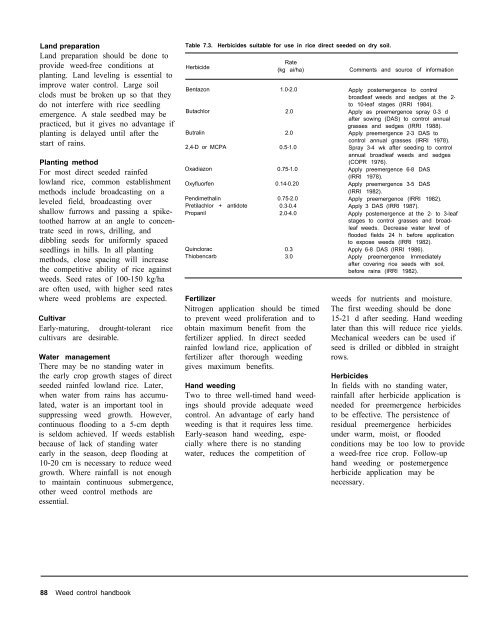A handbbok on Weed Control in Rice.pdf
A handbbok on Weed Control in Rice.pdf
A handbbok on Weed Control in Rice.pdf
Create successful ePaper yourself
Turn your PDF publications into a flip-book with our unique Google optimized e-Paper software.
Land preparati<strong>on</strong><br />
Land preparati<strong>on</strong> should be d<strong>on</strong>e to<br />
provide weed-free c<strong>on</strong>diti<strong>on</strong>s at<br />
plant<strong>in</strong>g. Land level<strong>in</strong>g is essential to<br />
improve water c<strong>on</strong>trol. Large soil<br />
clods must be broken up so that they<br />
do not <strong>in</strong>terfere with rice seedl<strong>in</strong>g<br />
emergence. A stale seedbed may be<br />
practiced, but it gives no advantage if<br />
plant<strong>in</strong>g is delayed until after the<br />
start of ra<strong>in</strong>s.<br />
Plant<strong>in</strong>g method<br />
For most direct seeded ra<strong>in</strong>fed<br />
lowland rice, comm<strong>on</strong> establishment<br />
methods <strong>in</strong>clude broadcast<strong>in</strong>g <strong>on</strong> a<br />
leveled field, broadcast<strong>in</strong>g over<br />
shallow furrows and pass<strong>in</strong>g a spike-<br />
toothed harrow at an angle to c<strong>on</strong>cen-<br />
trate seed <strong>in</strong> rows, drill<strong>in</strong>g, and<br />
dibbl<strong>in</strong>g seeds for uniformly spaced<br />
seedl<strong>in</strong>gs <strong>in</strong> hills. In all plant<strong>in</strong>g<br />
methods, close spac<strong>in</strong>g will <strong>in</strong>crease<br />
the competitive ability of rice aga<strong>in</strong>st<br />
weeds. Seed rates of 100-150 kg/ha<br />
are often used, with higher seed rates<br />
where weed problems are expected.<br />
Cultivar<br />
Early-matur<strong>in</strong>g, drought-tolerant rice<br />
cultivars are desirable.<br />
Water management<br />
There may be no stand<strong>in</strong>g water <strong>in</strong><br />
the early crop growth stages of direct<br />
seeded ra<strong>in</strong>fed lowland rice. Later,<br />
when water from ra<strong>in</strong>s has accumu-<br />
lated, water is an important tool <strong>in</strong><br />
suppress<strong>in</strong>g weed growth. However,<br />
c<strong>on</strong>t<strong>in</strong>uous flood<strong>in</strong>g to a 5-cm depth<br />
is seldom achieved. If weeds establish<br />
because of lack of stand<strong>in</strong>g water<br />
early <strong>in</strong> the seas<strong>on</strong>, deep flood<strong>in</strong>g at<br />
10-20 cm is necessary to reduce weed<br />
growth. Where ra<strong>in</strong>fall is not enough<br />
to ma<strong>in</strong>ta<strong>in</strong> c<strong>on</strong>t<strong>in</strong>uous submergence,<br />
other weed c<strong>on</strong>trol methods are<br />
essential.<br />
88 <strong>Weed</strong> c<strong>on</strong>trol handbook<br />
Table 7.3. Herbicides suitable for use <strong>in</strong> rice direct seeded <strong>on</strong> dry soil.<br />
Herbicide<br />
Bentaz<strong>on</strong><br />
Butachlor<br />
Butral<strong>in</strong><br />
2,4-D or MCPA<br />
Oxadiaz<strong>on</strong><br />
Oxyfluorfen<br />
Pendimethal<strong>in</strong><br />
Pretilachlor + antidote<br />
Propanil<br />
Qu<strong>in</strong>clorac<br />
Thiobencarb<br />
Rate<br />
(kg ai/ha) Comments and source of <strong>in</strong>formati<strong>on</strong><br />
1.0-2.0<br />
2.0<br />
2.0<br />
0.5-1.0<br />
0.75-1.0<br />
0.14-0.20<br />
0.75-2.0<br />
0.3-0.4<br />
2.0-4.0<br />
0.3<br />
3.0<br />
Fertilizer<br />
Nitrogen applicati<strong>on</strong> should be timed<br />
to prevent weed proliferati<strong>on</strong> and to<br />
obta<strong>in</strong> maximum benefit from the<br />
fertilizer applied. In direct seeded<br />
ra<strong>in</strong>fed lowland rice, applicati<strong>on</strong> of<br />
fertilizer after thorough weed<strong>in</strong>g<br />
gives maximum benefits.<br />
Hand weed<strong>in</strong>g<br />
Two to three well-timed hand weed-<br />
<strong>in</strong>gs should provide adequate weed<br />
c<strong>on</strong>trol. An advantage of early hand<br />
weed<strong>in</strong>g is that it requires less time.<br />
Early-seas<strong>on</strong> hand weed<strong>in</strong>g, espe-<br />
cially where there is no stand<strong>in</strong>g<br />
water, reduces the competiti<strong>on</strong> of<br />
Apply postemergence to c<strong>on</strong>trol<br />
broadleaf weeds and sedges at the 2-<br />
to 10-leaf stages (IRRI 1984).<br />
Apply as preemergence spray 0-3 d<br />
after sow<strong>in</strong>g (DAS) to c<strong>on</strong>trol annual<br />
grasses and sedges (IRRI 1988).<br />
Apply preemergence 2-3 DAS to<br />
c<strong>on</strong>trol annual grasses (IRRI 1978).<br />
Spray 3-4 wk after seed<strong>in</strong>g to c<strong>on</strong>trol<br />
annual broadleaf weeds and sedges<br />
(COPR 1976).<br />
Apply preemergence 6-8 DAS<br />
(IRRI 1978).<br />
Apply preemergence 3-5 DAS<br />
(IRRI 1982).<br />
Apply preemergence (IRRI 1982).<br />
Apply 3 DAS (IRRI 1987).<br />
Apply postemergence at the 2- to 3-leaf<br />
stages to c<strong>on</strong>trol grasses and broadleaf<br />
weeds. Decrease water level of<br />
flooded fields 24 h before applicati<strong>on</strong><br />
to expose weeds (IRRI 1982).<br />
Apply 6-8 DAS (IRRI 1986).<br />
Apply preemergence Immediately<br />
after cover<strong>in</strong>g rice seeds with soil,<br />
before ra<strong>in</strong>s (IRRI 1982).<br />
weeds for nutrients and moisture.<br />
The first weed<strong>in</strong>g should be d<strong>on</strong>e<br />
15-21 d after seed<strong>in</strong>g. Hand weed<strong>in</strong>g<br />
later than this will reduce rice yields.<br />
Mechanical weeders can be used if<br />
seed is drilled or dibbled <strong>in</strong> straight<br />
rows.<br />
Herbicides<br />
In fields with no stand<strong>in</strong>g water,<br />
ra<strong>in</strong>fall after herbicide applicati<strong>on</strong> is<br />
needed for preemergence herbicides<br />
to be effective. The persistence of<br />
residual preemergence herbicides<br />
under warm, moist, or flooded<br />
c<strong>on</strong>diti<strong>on</strong>s may be too low to provide<br />
a weed-free rice crop. Follow-up<br />
hand weed<strong>in</strong>g or postemergence<br />
herbicide applicati<strong>on</strong> may be<br />
necessary.











